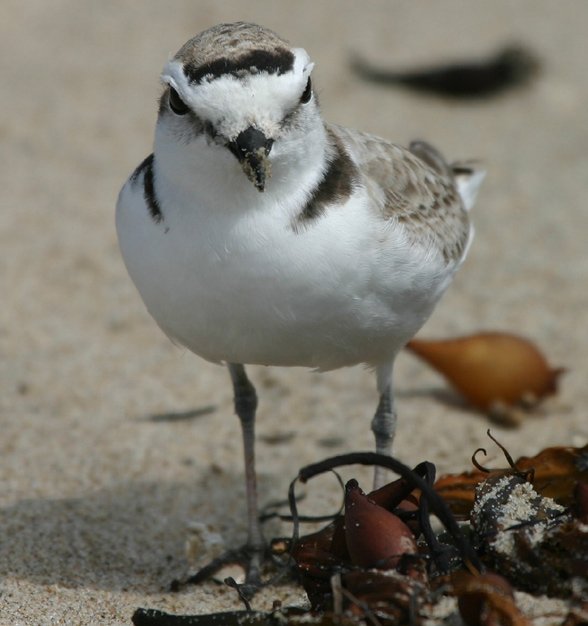
Habitat
Western Snowy Plovers are small shorebirds that occur primarily
on sandy beaches and intertidal areas of marine and estuarine
habitats, but also occur in some inland areas such as salt
evaporator ponds, riverbeds, lakes, and ponds. Along the Pacific
Coast, Snowy Plovers are distributed on the mainland and offshore
islands from southern Washington to Baja California Sur,
Mexico.
Breeding Season
The plover's breeding season runs from March through September.
During the breeding season, Snowy Plovers typically establish nest
sites in non-vegetated areas of open sandy beaches and estuaries.
In the Monterey Bay area they nest on beaches, levees, slough
peninsulas and islands, and in dry salt pond beds from April
through August. Snowy plovers may remain at the breeding location
during the non-breeding period, or migrate to other areas. They
feed on an assortment of terrestrial invertebrates, including brine
flies, and are often seen foraging with a variety of other
shorebirds, particularly during low tide cycles.
Loss of Nesting Habitat

Widespread loss of nesting habitat has resulted in significant
declines of this species. These declines are attributed to a
variety of disturbances including development in coastal areas,
off-road vehicles, feral and uncontrolled domestic animals and
perdition from avian and mammalian predators.
Their habit of nesting on sandy marine beaches has brought them
into constant contact with humans using these areas for recreation.
The increase in nesting populations at salt ponds and other inland
areas is likely opportunistic and may compensate somewhat for
increased human disturbance at the coastal nesting sites.
Why is Bowser not Allowed on the Beach?
Dogs are allowed and welcome at the cache site as noted by the
this cache's attributes. However, many of Monterey County's beaches
are closed to our K9 friends. This is because uncontrolled dogs can
be disruptive to the endangered Snowy Plover nesting ground. A
Snowy Plover will permanently abandon a nest leaving unhatched eggs
if disturbed.
Note to the Handicapped
The cache is accessable to the Handicapped. The distance from
parking and the elevation changes require that the cacher be in
reasonable physical condition.
Thank you.
Photos - Callie Bowdish
Original Cache Container - X-Ray Tech -
"Let Me Give You A Little Cache"
05/08 Replacement Cache Container - el Jim Industries
09/09 Cache Container Replacement - Roanq
09/10 Replacement Cache Container(again) - el Jim
Industries
CONGRATULATIONS!!!
Hidey Hunter FTF
"I sat for a while just looking out at the bay."